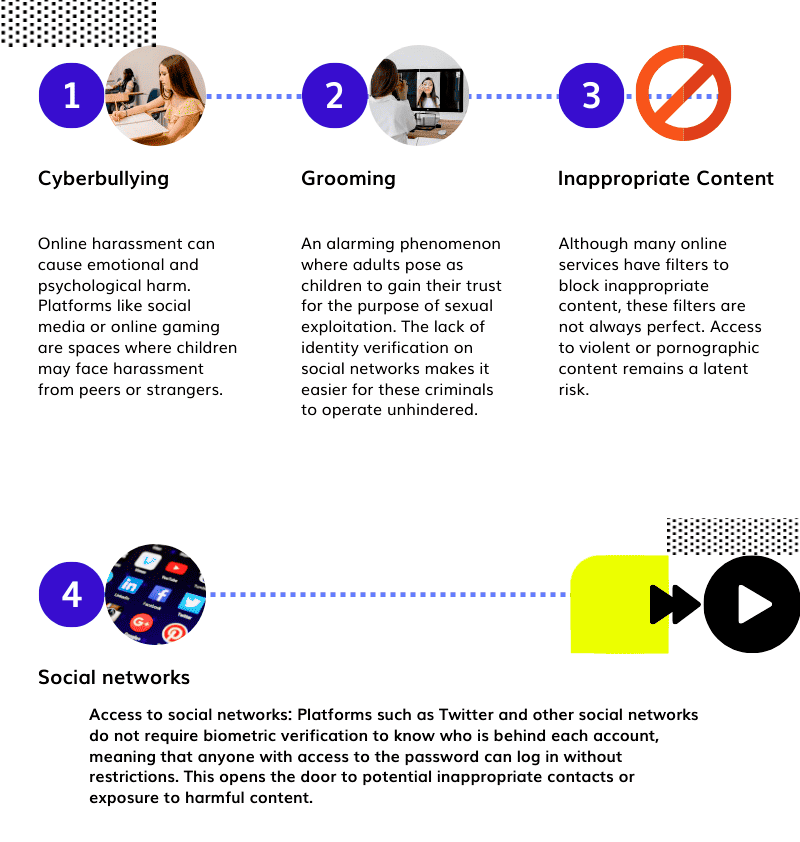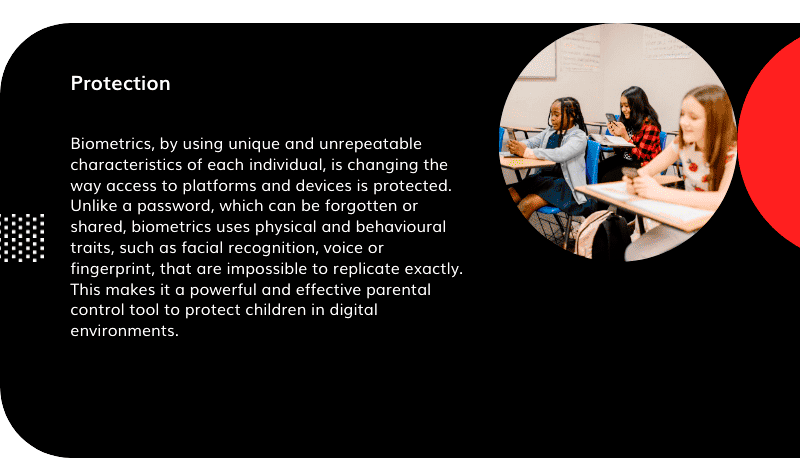We can’t put up barriers to progress. Our children are digital natives, and raising them in isolation from the advancements we’re witnessing doesn’t seem wise. The internet and AI present countless opportunities for their growth, from accessing educational content to staying connected with friends.
However, opening the door to this limitless universe also invites significant risks.
Many parents and guardians are shocked to discover that, even at a young age, children can bypass security measures like passwords. Once a child learns to change the home router settings or install a VPN, they can suddenly access sites they shouldn’t be visiting, given their age and maturity.
Biometrics may be the ultimate solution to protect your children online.
Online dangers for children
The reality is that, with their innocence and boundless curiosity, children are vulnerable online and face a range of threats:
- Cyberbullying: Platforms like social media or online gaming spaces can expose children to bullying from peers or strangers. Most of these platforms lack robust identity verification methods, enabling the creation of fake identities.
- Grooming (sexual predation): A deeply concerning phenomenon where adults pose as children to gain young people’s trust for sexual exploitation. The absence of identity verification on social networks makes it easier for these offenders to operate unchecked.
- Inappropriate content: While many online services filter inappropriate content, these filters aren’t foolproof. Access to violent or pornographic material remains a persistent risk.
- Payments and gambling in online games: The reward-based mechanics in many games (loot boxes) can be financially harmful for families and can even foster addictive behaviour in children.
A tech-savvy child, without adequate awareness of these dangers, is at serious risk of encountering these threats.
It is the responsibility of parents and guardians to monitor, limit, and supervise the way children use technology and the apps they access each day. Safe mechanisms must be put in place to protect their well-being. Yet, traditional security measures like passwords or security questions aren’t always enough to protect minors. A common scenario is when a child takes control of the home Wi-Fi and changes the password, giving unsupervised internet access to themselves and their friends—whether they’re gathering to do homework or play video games.
Sound familiar?
How kids bypass restrictions?
It’s remarkable how quickly children learn to use the tools available to them. In many cases, kids figure out how to install Virtual Private Networks (VPNs), which allow them to bypass geographic content restrictions and parental controls that parents or guardians have put in place.

With VPNs, children can access restricted content and hide their online activity, making it difficult for parents to monitor what they’re up to. The real concern is that many of these services are free or very affordable, and with a simple internet search, children can learn to use them with ease.
Real consequences for minors

![]()
One possible solution for a simple, universal access key for any service at home is biometrics.
Biometric technologies like facial recognition could be a vital tool for parents and guardians to control their children’s access.
Passwords and parental controls: an outdated solution
For years, traditional parental security methods, such as passwords and PINs, have served as the primary line of defence for accessing devices and platforms. However, when it comes to protecting minors in digital spaces, these methods are proving increasingly insecure.
Today, most children can figure out a password just by watching their parents or, at worst, by adjusting device settings when unsupervised. The issue is compounded when children share these passwords with friends or even strangers.
Moreover, access to tutorials on YouTube or Google makes it easy for them to learn how to bypass access restrictions, either by using advanced settings on devices or third-party apps.
Children are often unaware of the risks associated with sharing confidential information. What happens, for example, when a child shares a social media password with a friend? In many cases, this can lead to risky situations, from identity theft to unwanted interactions with strangers.
Drawbacks of password-based parental controls
Password-based security poses several challenges for online child safety:
- Ease of Unauthorised Access: Any child who knows the password can access applications or devices that may be inappropriate for their age or maturity level.
- Management Challenges: For parents, remembering and managing multiple passwords for each parental control platform is difficult, leading them to simplify passwords (such as reusing the same PIN across apps). This makes passwords easy to guess.
- Vulnerability to External Threats: Passwords can be hacked or stolen, and children may share them without understanding the risks involved.
Studies show that most of us (9 out of 10 users) reuse passwords across accounts and devices because managing multiple passwords is challenging. Coupled with the fact that 90% of passwords are vulnerable, it’s clear that passwords are an outdated solution for environments where security should be rock-solid—especially when protecting minors.
Consequences for minors of week passwords
There are countless cases where passwords alone have failed to protect minors. Platforms like Twitter and other social networks don’t require biometric verification to confirm the identity behind each account, meaning anyone with access to the password can log in without restrictions. While some networks, like LinkedIn, have started verifying accounts through ID checks and facial biometrics, this approach is largely absent from the platforms popular with teenagers.
In online gaming environments, many children log in with accounts created by their parents. In systems that only require a simple PIN, minors can interact with strangers without adequate oversight.
Since these platforms don’t offer sufficient security assurances for children, we need to explore more reliable alternatives to control access. This is where biometrics come into play as a more advanced and secure solution.
Biometrics as a solution to protect minors
Advantages of biometrics over traditional methods
Unlike passwords, biometrics cannot be shared. This means that only the authorised child has access, eliminating the risk of another minor logging in using the password.
Additionally, as children grow, biometric systems can adapt to their physical changes by updating continuously. This simplifies security management over time since, unlike passwords, there is no need for periodic changes.
Lastly, biometrics can be applied passively in the devices being used. For instance, a smartphone could perform facial recognition checks periodically to ensure it is still the authorised child using the device.
Practical examples of biometric usage include controlled access to prevent identity theft on social media, authorised logins for educational apps or games, and in homes with shared devices, biometrics would allow each family member to have personalised access. This ensures that parents can be confident their child won’t be exposed to inappropriate content or applications when using the family phone or tablet.

Secure and personalised access for every family member
Biometrics enable the creation of personalised profiles for each user within a single device. For example, a family tablet can recognise whether it is being used by an adult or a child and automatically adjust security options and permissions according to the user’s biometric profile. When the device detects a child’s face or fingerprint, it automatically limits access to certain applications and blocks sensitive features.
For parents, this offers a tremendous advantage as they do not need to manually configure each restriction or constantly toggle controls. Biometric systems ensure that, regardless of who is using the device, access is adjusted to the appropriate security level for each family member.
Passive verification of children
Imagine a child using a mobile phone or tablet who decides to pass the device to a friend. With passive verification technology, the device can perform periodic user checks in the background, confirming that the authorised user is still using the device. If the system detects a change in the user (for instance, if the face or voice does not match the registered child’s profile), the device can automatically lock until the correct user reactivates it through biometric authentication.
This type of passive verification adds an extra layer of security, allowing parents to be confident that only the authorised user has access at any time. Moreover, this control is transparent and does not require constant adult intervention, reducing the need for ongoing supervision.
Blocking applications and networks without biometric verification
The vast majority of social networks allow account creation with minimal verification requirements, making it easy for individuals with false identities to navigate without restrictions. This anonymity poses a danger for minors, as it enables adults with malicious intent to interact with them without security barriers. With biometric systems, parents can establish that only their children have access to networks or applications with strict verification controls, automatically blocking platforms that do not meet these standards.
In the case of messaging apps and online games, biometrics enable parents to configure restrictions that limit minors’ interactions to previously verified contacts. For instance, some online games feature open chats where minors can be targets of grooming or cyberbullying.
Conclusions
In recent years, biometrics have emerged as a straightforward and highly secure solution for situations requiring identity validation. This allows parents and guardians to maintain a more controlled digital environment, blocking access to unsafe platforms and ensuring that only authorised minors can use certain devices and features.
Beyond its protective function, biometrics also present an educational opportunity, helping children understand the importance of privacy and digital security. Involving minors in the setup process of these technologies fosters a culture of cybersecurity from an early age, preparing them for responsible technology use in the future.
Contact us if you want to find out how we can help you find a balance between security and usability.

I’m a Software Engineer with a passion for Marketing, Communication, and helping companies expand internationally—areas I’m currently focused on as CMO at Mobbeel. I’m a mix of many things, some good, some not so much… perfectly imperfect.

GUIDE
Identify your users through their face
In this analogue-digital duality, one of the processes that remains essential for ensuring security is identity verification through facial recognition. The face, being the mirror of the soul, provides a unique defence against fraud, adding reliability to the identification process.




